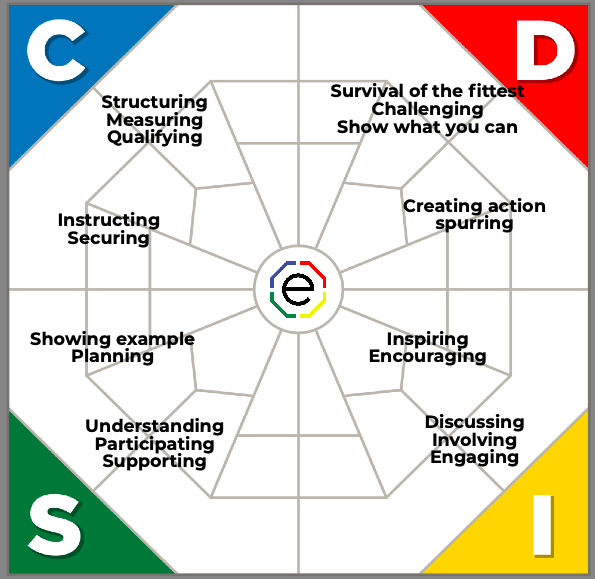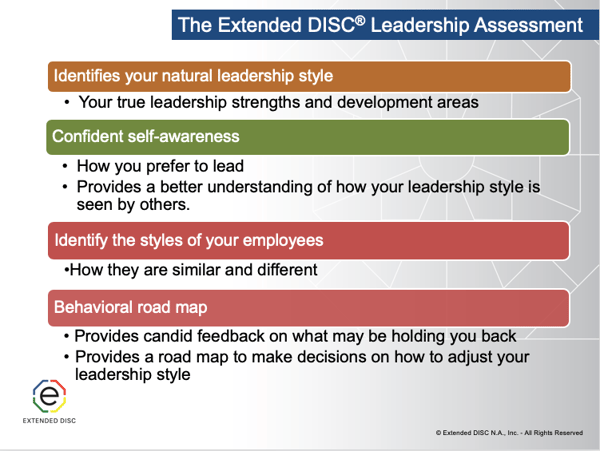Are you taking advantage of your leadership strengths to communicate, influence, and motivate your team members?
The Extended DISC® Leadership Assessment
 The Extended DISC® Leadership Assessment identifies your natural leadership style. It further identifies your true leadership strengths and possible development areas. It can provide candid feedback on what my be holding you back. You will build self-awareness by understanding your leadership style; how you prefer to lead. You'll also gain better understanding of how your leadership styles is seen by others. Often times these gaps between how we see ourselves leading and how others see us, can create the greatest opportunity for our development.
The Extended DISC® Leadership Assessment identifies your natural leadership style. It further identifies your true leadership strengths and possible development areas. It can provide candid feedback on what my be holding you back. You will build self-awareness by understanding your leadership style; how you prefer to lead. You'll also gain better understanding of how your leadership styles is seen by others. Often times these gaps between how we see ourselves leading and how others see us, can create the greatest opportunity for our development.
Self-awareness is critical, but to truly be able to improve our ability to lead, we need to be able to identify the style of our employees; how they are similar and how they are different. Ultimately, we are trying to create a roadmap to understanding when to use our strengths and when to make the best adjustments in situations.
There are different Extended DISC tools a manager or leaders can use. Anyone will benefit from the standard Individual Assessment. It identifies your natural style as well as, how you prefer to communicate, how you prefer to make decisions, what tends to motivate you, etc. You can focus in by instead choosing the Manager Assessment or the Leadership Assessment. They are all generated from a one-time Extended DISC® Questionnaire.
Leadership Styles

The active and task-focused D-style leaders are decisive and large and in charge. They strive to maintain maximum control where the flow of authority and communication goes in one direction; they lead and you follow. They may challenge you in order to spur you to action, show what you can do, and achieve quick execution of their goals. They are usually comfortable making the 'cold' decisions. However, D-style leaders may need to consider others more and know when to avoid taking too many risks.
The social I-style leader is also active, but they are more people-focused and informal. They prefer to lead by involving and encouraging their team members. I-style leaders emphasize personal relationships, and engaging and involving everyone. They promote competitiveness through inspiration, and not by pressure. However, I-style leaders may need practice staying organized and maintaining focus on the end goals.
The more reserved and people-oriented S-style tends be a supportive leader who shows their employees how to proceed, often by setting an example. An S-style leader encourages and emphasizes loyalty, consensus, and sincerity. S-style leaders likes to plan. They emphasize gradual evolution, while strongly focusing on agreed upon long-term goals. However, S-style leaders may need to take more action, decide more quickly, and at times, think 'outside the box'.
The reserved and task-oriented C-style leaders emphasize quality, structure and compliance with righteousness. They tend to maintain distance from their teams thus, creating less interpersonal connection. The C-style leader focuses on measuring and qualifying tasks and goals. They instruct to make sure everyone knows what is specifically expected. C-style leaders prefer using emails and written directions to communicate. However, C-style leaders may need to be less critical, and not so hard on themselves. They can practice being more open and prepared when faced with surprises or when things don't go as planned.
Capitalizing on your leadership strengths
 There is no ideal leadership style. Every leadership style has strengths and areas of development. There is no one leadership style that is automatically successful. Everyone has their own unique leadership strengths. Keep in mind, others would love to have your strengths, but we have a tendency to focus more on our shortcomings.
There is no ideal leadership style. Every leadership style has strengths and areas of development. There is no one leadership style that is automatically successful. Everyone has their own unique leadership strengths. Keep in mind, others would love to have your strengths, but we have a tendency to focus more on our shortcomings.
The most effective leaders know their strengths, but don't overuse them. They are aware of areas they avoid because it tends to drain their energy, but they do not ignore them. Most importantly, they know when and how to adjust their leadership style effectively. They are self-aware and they identify the styles of their employees so they don't make the mistake of assuming that everyone shares their strengths. They make adjustments so they can communicate, influence, and motivate their team members more effectively.
The Extended DISC® Leadership Assessment identifies the leadership behaviors which are more comfortable and which take more energy. It further identifies the strengths of the person's leadership style. Strengths need to be maximized, but we need to be careful not to overuse them to the point they become a liability. As you read through your leadership competences and strengths, try prioritizing up to three items you feel would have the greatest positive impact of your performance if you were to consciously improve in those areas; think about what you need to practice and adjust to make those improvements.
The report also includes The Improving Your Success as A Manager section. It provides suggestions and reminders for you to be more consciously aware of when you are leading others. They are based on your natural leadership style. If you make these adjustments, which will take energy and practice, you could improve your success as a leader.

